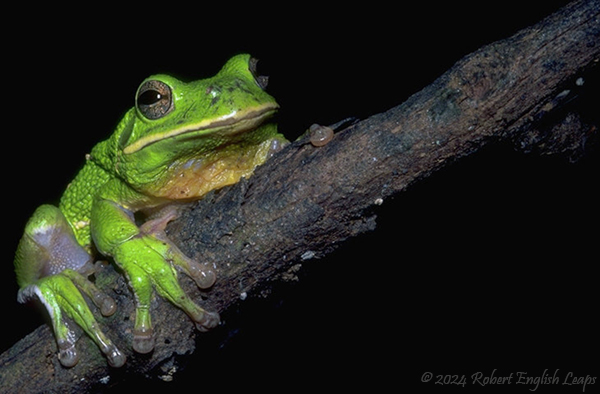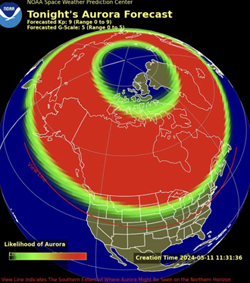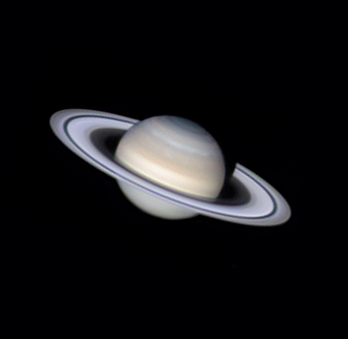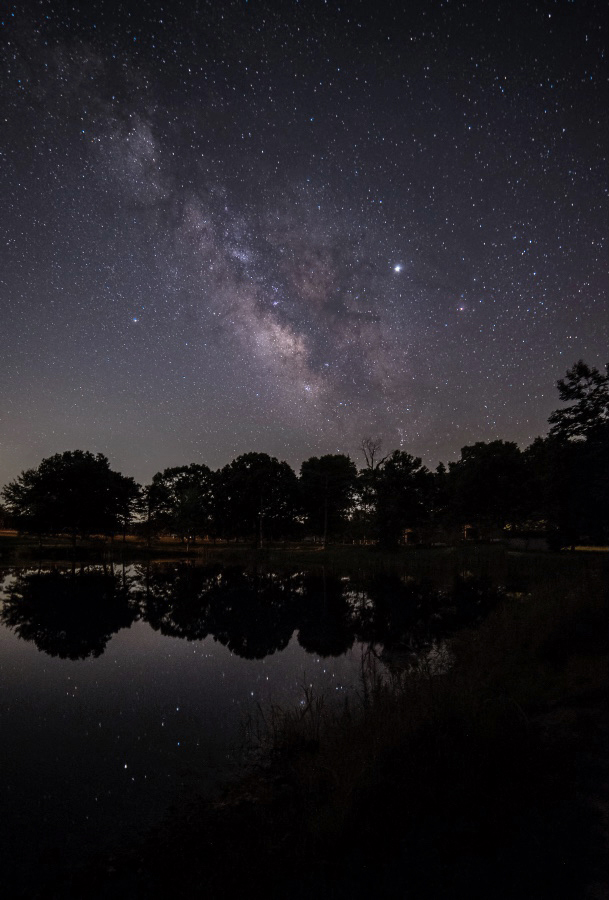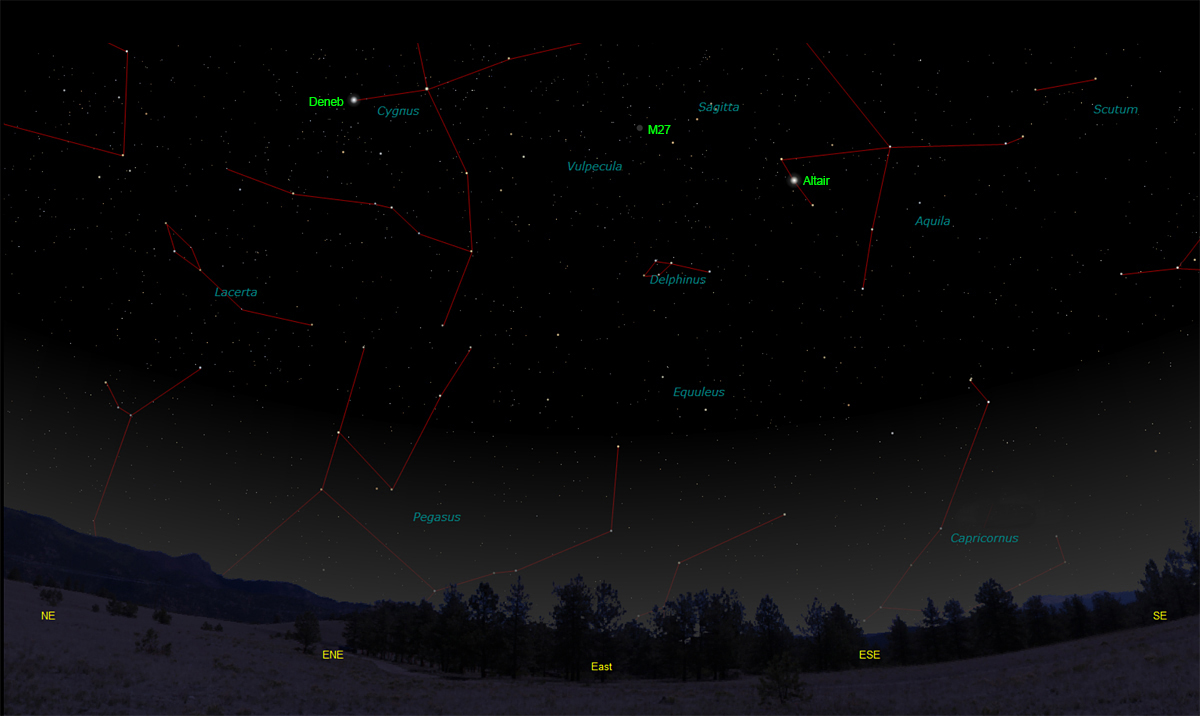The purpose of this feature is to give scout leaders, educators and naturalists an idea of some of the natural events coming up each month. We will try to cover a variety of natural events ranging from sky events to calling periods of amphibians, bird and mammal watching tips, prominent wildflowers and anything else that comes to mind. We will also note prominent constellations appearing over the eastern horizon at mid-evening each month for our area for those who would like to learn the constellations. If you have suggestions for other types of natural information you would like to see added to this calendar, let us know! Though we link book references to nationwide sources, we encourage you to support your local book store whenever possible.
Notes From June 2024
It was a beautiful morning and our early start resulted in pleasant conditions for paddling. One of the local residents our group spotted was this Cottonmouth sunning itself on a rock jutting out into the water. We had a total of three Cottonmouths, two of which were behind the one shown and noticed only when one of our friends was going back through the images! We saw and heard many birds along the river, and coming back we saw a Red Bat flying along the river in bright sunlight. I've seen them before while kayaking, including one very close view on the Duck River.
We didn't get a Barn Owl, but as we were sitting beside a small pond at the first listening stop, a Red Bat made a number of low passes over the pond. It sped along just over the water's surface dipping its mouth into the water several times on each pass. This is the only way a bat can get a drink of water. Their legs are not strong enough or configured in the right way to enable them to stand upright. The sun had already set, and it was getting darker all the time. Although I knew it would be difficult, I tried to get an image. Just getting the camera on the moving bat for some of each pass was a challenge! So was getting the autofocus to work in the low light. You can get a sense of its speed over the water by looking at the drops of water still hanging above the surface in the image at right. The image is brighter than what I was seeing through the viewfinder. I'll try to catch it earlier in the evening next time. Red bats often roost in trees and have been found roosting in honeysuckle.
The TAMP protocol calls for listening for five minutes at each listening stop. Each species heard is noted, and the strength of the chorus is quantified using a calling index. We worked our way around the route as a full moon rose in the east. It's a pleasant way to spend an evening.
Unfortunately, due to the faintness of the call, I did not get a usable recording. I wasn't able to return last year, so this year I updated my recording setup and hoped I might get another chance. Barking Treefrogs usually require a fairly high ambient temperature to call - usually above 73 degrees. So a certain amount of luck would be involved if we were to be successful. Our first night hike was cancelled due to a prediction of thunderstorms in the area. We rescheduled for a few weeks later. It was truly a fun night - though it was warm, it wasn't humid, and we were buoyed up by a really great group of people. Towards the end of the hike we were told about a location that would be closer to where we heard the Barking Treefrogs last year.
We arrived at a residence that had several woodland ponds behind it. The
owners, Tom and Barbara Elliott, met on The Farm and bought the property
16 years ago. Even before they built a house, Tom was excavating
the ponds and working on the habitat. The ponds were completed around 2010.
After being together 46 years and raising four kids, and enjoying seven
grandchildren, Tom passed away from
lung cancer three years ago. When we pulled into the driveway, we immediately heard Barking Treefrogs. They were close by and beautifully clear! The raspy trills of Cope's Gray Treefrogs and the ticking of Eastern Cricket frogs accompanied the two Barking Treefrogs. This time we were ready. We recorded the frogs and just savored the hollow-sounding "barks" of the treefrogs with our night-hikers. Tom's work had paid off, and the ponds he worked so hard to excavate were providing a home for a new species for Lewis County. More importantly, he left a legacy for all that will come later and enjoy that habitat. Thanks, Tom. Sky Events for June 2024:
We recommend checking the NASA Space Weather Prediction Center forecast every few days for upcoming auroral displays. For a means to gage the graphics depicted there, the prediction for the aurora on May 11th, during the great magnetic storm beginning on May 10th, is shown here. Note that while the thin red line showing the southern limit of the auroral display does not quite extend into Tennessee, we had a really bright display on the 10th.
Morning Sky:
Jupiter rises about 2 hours before the Sun at the beginning of the month in Taurus. On July 1st, look for it thirty minutes before sunrise about 18 degrees above the horizon East-Northeast. It will be much brighter than Mars.
Evening Sky: Venus sets shortly after sunset on July 1st. If you have a flat western horizon, look for it with binoculars about 15 minutes after sunset low in the West-Northwest. It is bright but it is very close to the horizon. Mercury is also visible low in the West-Northwest after sunset, a little higher in the sky than Venus but much fainter. It's another object that binoculars will help you see. Try for it about 30 minutes after sunset. Saturn is easier to see but does not rise until around midnight at the first of the month, in Aquarius. We are almost passing through the plane of Saturn's rings, and they are reduced to be a very fine line on each side of the planet. It will not be a good telescopic target until just before dawn, when it will be in the South about 47 degrees above the horizon.
The views below show the
sky looking east at 10:30pm EDT on July 15th. The first chart shows the sky
with the constellations outlined and names depicted. Star and planet names
are in green. Constellation names are in blue. The second view
shows the same scene without labels. Prominent constellations this month in the
eastern sky are
Cygnus, the Swan, with its bright star
Deneb, and
Aquila, the Eagle, with its bright star
Altair. Below and to the left of Altair is the constellation of
Delphinus, the
Dolphin, looking like it's leaping over the eastern horizon. Above Delphinus look for the arrow-like form of
Sagitta, the Arrow. Between Sagitta and Cygnus lie the faint stars of
Vulpecula the Fox.
Capricornus,
The Seagoat, is one of the stranger inhabitants of the night sky. According
to legend it is half fish and half goat. I don't think it's a popular tale to tell around a campfire. The star clouds wind through the constellations of Scutum, Aquilla, Sagitta, Vulpecula and Cygnus, then on through Lacerta and Cassiopeia. Some of the features of the Milky Way, like the Lagoon Nebula, you can see with the naked eye on a clear dark night. Others, like M27, the Dumbbell Nebula in Vulpecula, require binoculars to spot. It can be seen as a fuzzy patch in binoculars (don't expect the bright colors - just a grayish green spot). Use the easy-to-find stars of nearby Sagitta to locate it, using the finder chart here.
On Learning the Constellations: Try learning a few constellations each month, and then following them through the seasons. Once you associate a particular constellation coming over the eastern horizon at a certain time of year, you may start thinking about it like an old friend, looking forward to its arrival each season. The stars in the evening scene above, for instance, will always be in the same place relative to the horizon at the same time and date each July. Of course, the planets do move slowly through the constellations, but with practice you will learn to identify them from their appearance. In particular, learn the brightest stars (like Deneb and Altair in the above scene), for they will guide you to the fainter stars. Once you can locate the more prominent constellations, you can "branch out" to other constellations around them. It may take you a little while to get a sense of scale, to translate what you see on the computer screen or what you see on the page of a book to what you see in the sky. Look for patterns, like the stars that make up the constellation Cygnus. The earth's rotation causes the constellations to appear to move across the sky just as the sun and the moon appear to do. If you go outside earlier than the time shown on the charts, the constellations will be lower to the eastern horizon. If you observe later, they will have climbed higher. As each season progresses, the earth's motion around the sun causes the constellations to appear a little farther towards the west each night for any given time of night. If you want to see where the constellations in the above figures will be on August 15th at 10:30pm EDT, you can stay up till 12:30am EDT on July 16th and get a preview. The westward motion of the constellations is equivalent to two hours per month. Recommended: Sky & Telescope's Pocket Star Atlas is beautiful, compact star atlas. A good book to learn the constellations is Patterns in the Sky, by Hewitt-White. For sky watching tips, an inexpensive good guide is Secrets of Stargazing, by Becky Ramotowski.
A good general reference book on astronomy is the Peterson
Field Guide,
A Field Guide to the Stars and Planets, by Pasachoff. The book retails for around $14.00.
The Virtual Moon Atlas is a terrific way to learn the surface features of the Moon. And it's free software. You can download the Virtual Moon Atlas here. Apps: The Sky Safari 6 basic version is free and a great aid for the beginning stargazer. We really love the Sky Safari 6 Pro. Both are available for iOS and Android operating systems. There are three versions. The Pro is simply the best astronomy app we've ever seen. The description of the Pro version reads, "includes over 100 million stars, 3 million galaxies down to 18th magnitude, and 750,000 solar system objects; including every comet and asteroid ever discovered." A nother great app is the Photographer's Ephemeris. Great for finding sunrise, moonrise, sunset and moonset times and the precise place on the horizon that the event will occur. Invaluable not only for planning photographs, but also nice to plan an outing to watch the full moon rise. Available for both androids and iOS operating systems.
Amphibians:
Recommended: The Frogs and Toads of North America, Lang Elliott, Houghton Mifflin Co. Archives (Remember to use the back button on your browser, NOT the back button on the web page!) Natural Calendar February 2024 Natural Calendar December 2023 Natural Calendar November 2023 Natural Calendar September 2023 Natural Calendar February 2023 Natural Calendar September 2022 Natural Calendar February 2022 Natural Calendar December 2021 Natural Calendar November 2021 Natural Calendar September 2021 Natural Calendar February 2021 Natural Calendar December 2020 Natural Calendar November 2020 Natural Calendar September 2020 Natural Calendar February 2020 Natural Calendar December 2019 Natural Calendar November 2019 Natural Calendar September 2019 Natural Calendar February 2019 Natural Calendar December 2018
Natural Calendar September 2018 Natural Calendar February 2018 Natural Calendar December 2017 Natural Calendar November 2017 Natural Calendar October 2017Natural Calendar September 2017 Natural Calendar February 2017 Natural Calendar December 2016 Natural Calendar November 2016 Natural Calendar September 2016Natural Calendar February 2016 Natural Calendar December 2015 Natural Calendar November 2015 Natural Calendar September 2015 Natural Calendar November 2014 Natural Calendar September 2014 Natural Calendar September 2013 Natural Calendar December 2012 Natural Calendar November 2012 Natural Calendar September 2012 Natural Calendar February 2012 Natural Calendar December 2011 Natural Calendar November 2011 Natural Calendar September 2011 Natural Calendar December 2010 Natural Calendar November 2010 Natural Calendar September 2010 Natural Calendar February 2010 Natural Calendar December 2009 Natural Calendar November 2009 Natural Calendar September 2009 Natural Calendar February 2009 Natural Calendar December 2008 Natural Calendar November 2008 Natural Calendar September 2008 Natural Calendar February 2008 Natural Calendar December 2007 Natural Calendar November 2007 Natural Calendar September 2007 Natural Calendar February 2007 Natural Calendar December 2006 Natural Calendar November 2006 Natural Calendar September 2006 Natural Calendar February 2006
Natural Calendar December 2005
Natural Calendar November 2005
Natural Calendar September 2005
Natural Calendar February 2005
Natural Calendar December 2004
Natural Calendar November 2004
Natural Calendar September 2004
Natural Calendar February 2004
Natural Calendar December 2003
Natural Calendar November 2003 Natural Calendar February 2003 Natural Calendar December 2002 Natural Calendar November 2002 Nature Notes Archives: Nature Notes was a page we published in 2001 and 2002 containing our observations about everything from the northern lights display of November 2001 to frog and salamander egg masses. Night scenes prepared with The Sky Professional from Software Bisque All images and recordings © 2024 Leaps
|
|
|



